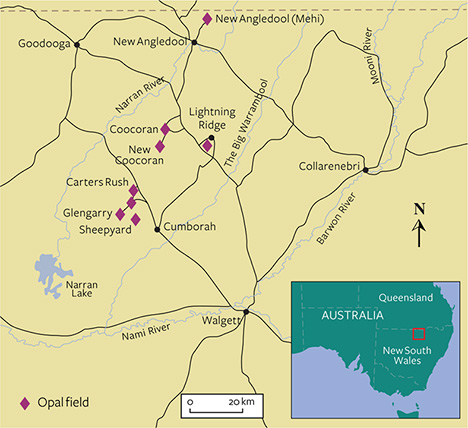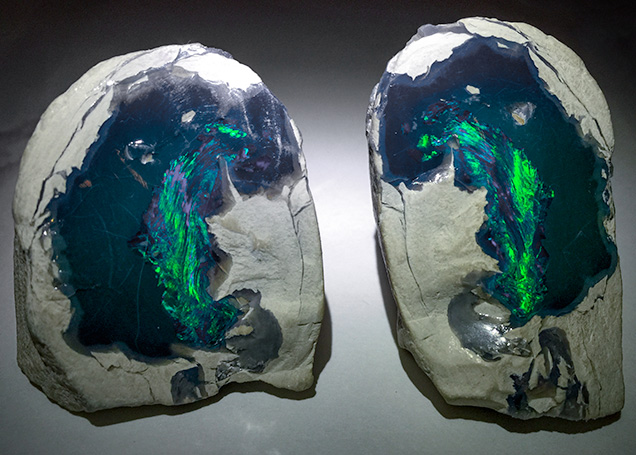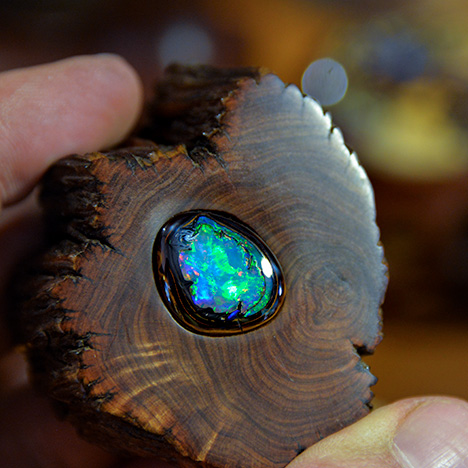Splendor in the Outback: A Visit to Australia's Opal Fields
ABSTRACT
With more than 170 years of opal mining and trading activity, Australia is synonymous with opal. Many world-renowned deposits are distributed in and along the margin of the Great Artesian Basin (GAB). Opal exports contribute roughly $85 million annually to the nation’s GDP. The industry employs thousands in the Outback communities and attracts more than 231,000 tourists per year. Opal tourism brings an estimated $324 million each year to these remote mining communities (National Opal Miners Association, n.d.).
To better understand the deposits, collect samples, and experience the opal culture, the authors traveled to Australia in June 2015 and visited four important opal fields: Lightning Ridge, Koroit, Yowah, and Quilpie (figure 1).

OPAL FORMATION IN THE GREAT ARTESIAN BASIN
Almost all of Australia’s opal deposits are geographically related to the GAB; therefore, the influence of this special environment on opalization is of particular interest. Opal is recovered predominantly from the sandstone or claystone units of Cretaceous age in all producing areas within or along the margin of the GAB. Back in the Cretaceous period, sea level fluctuation and general withdrawal occurred along the Australian shoreline. The local balance between rapid sedimentation and subsidence played a role in basin formation. During this period, the GAB was covered by a shallow, stagnant inland sea known as the Eromanga Sea, and the climate was dramatically different from today.
While experienced opal miners always follow certain structures in the rocks to mine the material, scientists have formed opalization models based on samples and field observations (figure 2). A variety of opalization theories have been proposed, including weathering theory, microbe theory, and syntectonic theory (Pecover, 2007). The most recent proposal is redox theory (Rey, 2013), which portrays a cold and poorly connected Eromanga Sea that lacked carbonates but was full of sediments rich in iron and organic matter. These sediments favored an anoxic environment in which anaerobic, pyrite-producing bacteria thrived. Thus, these sedimentary lithologies were extremely reactive to oxidation. During the Late Cretaceous period (about 97 to 60 million years ago), Australia experienced extensive acidic and oxidative weathering. Rey (2013) proposed that precious opal might form via this prolonged weathering and the opalized redox front, which was later buried and therefore well preserved by Cenozoic sediments.

Unfortunately, none of these models can resolve all the problems associated with opal formation. The different types of occurrences, such as black opal nodules and boulder opal ironstone concretions, also create challenges for researchers. Although an opalization model is not the purpose of this report, some of the most critical questions scientists must answer before forming any theories involve the supply of silica and water, space for opal growth, sedimentation conditions, and the ion exchange process. Not all opals formed the same way, and therefore multiple models may be required.
LIGHTNING RIDGE AND BLACK OPAL
Our first stop was Lightning Ridge, the traditional source for fine-quality black opal. The Lightning Ridge area is located in New South Wales, just south of the border from Queensland (figure 3). Opal was first discovered here in the late 1880s. The town of Lightning Ridge grew quickly after miners from other areas realized the value of this beautiful gem. Today, active mining operations are distributed both around the township and in the outlying areas such as Sheepyard, Grawin, Glengarry, and Carters Rush (again, see figure 3). Exploration is carried out in different areas of Lightning Ridge, and the authors visited one to the north of the township.

In Lightning Ridge, opal is generally recovered from the Finch Claystone unit of the Early Cretaceous age. This unit is directly below the Wallangulla Sandstone, which contains some Finch Claystone lenses; some of these lenses are opal bearing as well (figure 4). Previous underground mining channels are clearly visible at the contact zone between the two units on a well-exposed profile in the Lunatic Hill mine. The deposits are usually found less than 30 meters from the surface. Opal is found as nodules contained in the whitish clays; local miners refer to these as “nobbies” (figure 5). Opal is also recovered as thin seams in the outlying areas. The miners often follow structural features such as fractures and faults to look for opals.


Miners seeking black opal usually start with an underground operation. They will switch to an open pit (which Australians refer to as an “open cut”) only when they feel that it is more profitable. We saw mainly underground mining operations in this area.


A custom-designed digger extracts opal-bearing clays from the Finch Claystone unit, with the Wallangulla Sandstone unit acting as the roof of the underground mine (figure 6). Mined materials are drawn to the surface by a “blower” and transported to the washing plant (figure 7). A black opal washing plant generally consists of a water source, an agitator, and a sorting table. The washing process often takes one week to finish (figure 8). Opal, clay, and sandstone fragments are rotated in water within the agitator; this removes most of the clay from the opal without damaging the stone. At the end of the week, miners open the agitator and let the slurry flow out onto the sorting table, where they pick out the opals by hand (figure 9).


The clay is not very hard and is easily removed from the opals by washing and/or polishing. Due to their shape, opals from Lightning Ridge can be processed as cabochons and other freeforms (figure 10). Special care and design are necessary to use the black seam opal in jewelry (figure 11). White, crystal, and black opals can all be found in the Lightning Ridge region, but the fine-quality black opal is sought worldwide.


Fine black opal owes its beauty to its dark background and bright play-of-color (figure 12). A whole spectrum of colors can be found in black opals, with shades of blue and green the most common. Every piece is unique because of the pattern of the play-of-color, the number of colors exhibited, and the thickness of the finished pieces; this makes the stone extremely hard to grade. Although opal’s beauty is very subjective and choosing a stone is a deeply personal experience, market demand determines the overall price range. According to the miners and cutters, any play-of-color with an element of red dramatically increases the value of the stone. This was reflected in the prices of the loose stones we saw in the local market.

Opalized fossils are also found in Lightning Ridge. Plant and animal fossils of Cretaceous age, from microscopic organisms to giant dinosaur skeletons, are found in the GAB, and some have been partially or completely opalized (figure 13). With their precious play-of-color, these fossils are both a national treasure and excellent material for scientific research. They have attracted the attention of paleontologists all over the world. According to Dr. Elizabeth T. Smith from the University of New South Wales, the transparency of precious opal provides an unprecedented view inside the fossil.

QUEENSLAND FIELDS AND BOULDER OPAL
Across the state border north of Lightning Ridge is Queensland, considered the home of boulder opal. Opal was discovered in Queensland in the 1870s. In his geological survey report, Jackson (1902) reported: “At present about 295 men are engaged in the industry... The total value of gem stones produced from all opal-fields in Queensland is, as nearly as can be estimated, £131,000, or, up to the end of 1899, £116,000.” By the turn of the century, opal was popular among European consumers.
The state of Queensland has more than 300,000 km2 of land and about a dozen fields dedicated to opal exploration (again, see figure 1). Unlike other locations, the Queensland fields mainly produce boulder opal, which is extracted from the Desert Sandstone formation of Upper Cretaceous age. This formation, which experienced high erosion after its deposition, covers most of the state today as low ranges, tablelands, and isolated flat-topped hills (figure 14). A lower and softer opal-bearing sandstone and clay subunit is capped by a hard reddish siliceous subunit 5 to 16 meters thick (figure 15). This profile can be clearly seen at multiple mining operations. To better understand the boulder opal industry, the authors visited Koroit, Yowah, and Quilpie in central Queensland.


While underground and open-cut operations are found in all three fields, open-cut mining seems to be more prevalent. Opal is recovered from siliceous ironstone concretions, called “lily pads” or “nuts” by local miners depending on their morphology (figure 16). Miners examine certain structures to look for ironstone concretions, which are sometimes grouped along a line. As opposed to the washing process we saw in Lightning Ridge, miners need to split each concretion by hand to unveil the contents; only a limited number yield opal (figure 17).


Boulder opal is quite different from other varieties in terms of appearance. The term “boulder” refers to the host rock that is naturally attached to the finished product. When an opal-bearing ironstone concretion is opened, the distribution of precious opal is easy to see. Sometimes it is found in between the “skin” layers of the concretion or at its core (figure 18). Although opal at the kernel of a concretion may be large enough to separate from the host rock, most opals are too thin to be removed without being damaged (figure 19). Some opals occur on the surface of siliceous ironstone and follow the natural surface feature of the host rock; therefore, keeping it together with the rock adds more appeal to the stone. When precious opal occurs in cracks of the host rock, a well-polished stone can show truly spectacular abstract patterns (figure 20).



OPAL CULTURE
In all the mining towns we visited, we were impressed by the pride and passion of the locals, including some miners from overseas. For them, opal mining has become a way of life. Even during long periods without finding a gem-quality stone, the miners choose to stay. In our interviews, we were struck by their remarkable perseverance and drive. These were not the type of people who needed a steady paycheck or job security. They were willing to struggle and search for a discovery of opal, realizing that it might never come but also aware that with hard work it is possible. The economies of these small communities are largely based on opal mining, as well as opal-related tourism and recreational fossicking.
The Australian Opal Centre is under construction in Lightning Ridge (figure 21). Ms. Jenni Brammall, the manager of this project, informed us of the progress being made. While the foundation of the building was completed in 2014, fundraising is under way to support further operations. The opal center currently operates out of a small facility on the town’s main street. The new facility will serve as a museum, an educational center, and a platform to promote the national gemstone.

In Yowah, the authors met miner turned opal artist Eddie Maguire, who showed us his outstanding collection. He fashioned these stones in his home studio, applying creative cuts and unique displays (figure 22). Mr. Maguire’s collection consists entirely of carvings. In polishing the opal, he tries to preserve the natural form as much as possible. Many pieces are displayed on a frame or host, also designed and carved by Mr. Maguire. This method works very well with boulder opals since they are usually attached with their host rock, though many of the boulder opals in this collection stand on their own. He is working on opening a private museum in Yowah to exhibit his collection and educate people about opal.

CONCLUSION
Despite its dominance in the international market, the Australian opal industry still faces many challenges. A regional drought is one of the major obstacles for opal mining. The drought in the GAB has lasted for several years, and finding a water source is a problem for many miners. Although opal is well known, consumers need a better understanding of the stone’s varieties to truly appreciate its uniqueness. As in many other mining regions, a new generation of prospectors will be needed to sustain the future of Australia’s opal industry. From our conversations with miners we learned that many of the younger generation are moving to the cities. It is not a problem for now, but in another 20 to 30 years there could be a serious shortage of labor.
Meanwhile, many Australians are working hard to promote this spectacular gem, including miners, dealers, and collectors. At the beginning of our trip, Andrew Cody of Cody Opal hosted us in his Sydney flagship store. The store hosts the National Opal Collection, which features some of the rarest opalized fossils, including a three-meter-long intact skeleton of a pliosaur (figure 23). Australian opal formed around the same time as these prehistoric creatures. Mr. Cody and his brother Damien have been promoting Australian opal globally for years and in mainland China since 2012.

Since its discovery in the late 19th century, Australian opal has had a rich mining culture and a loyal consumer base. Despite the challenges the industry faces, the gem continues to fascinate scientists and jewelry enthusiasts with its unique formation and vivid play-of-color.



